

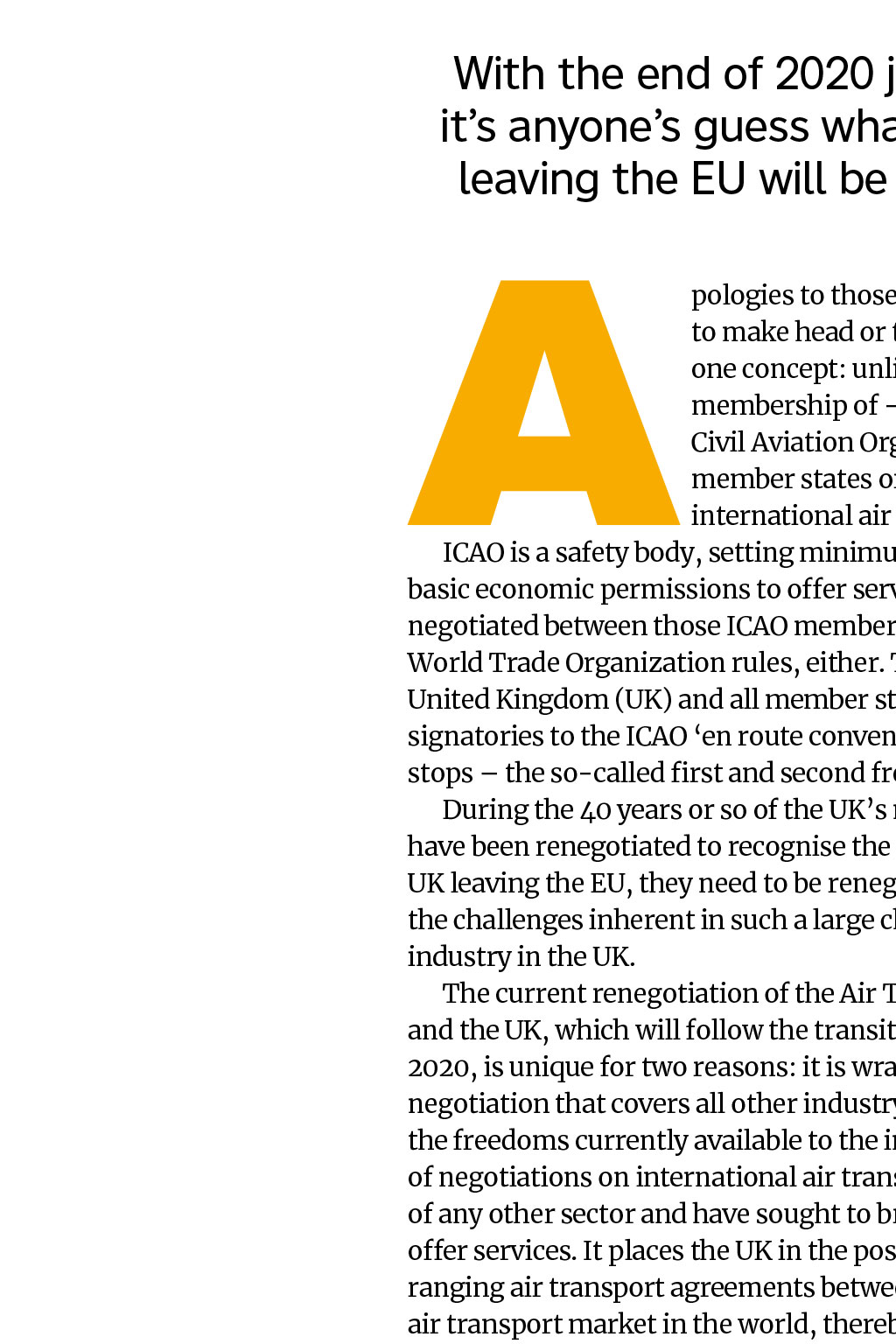
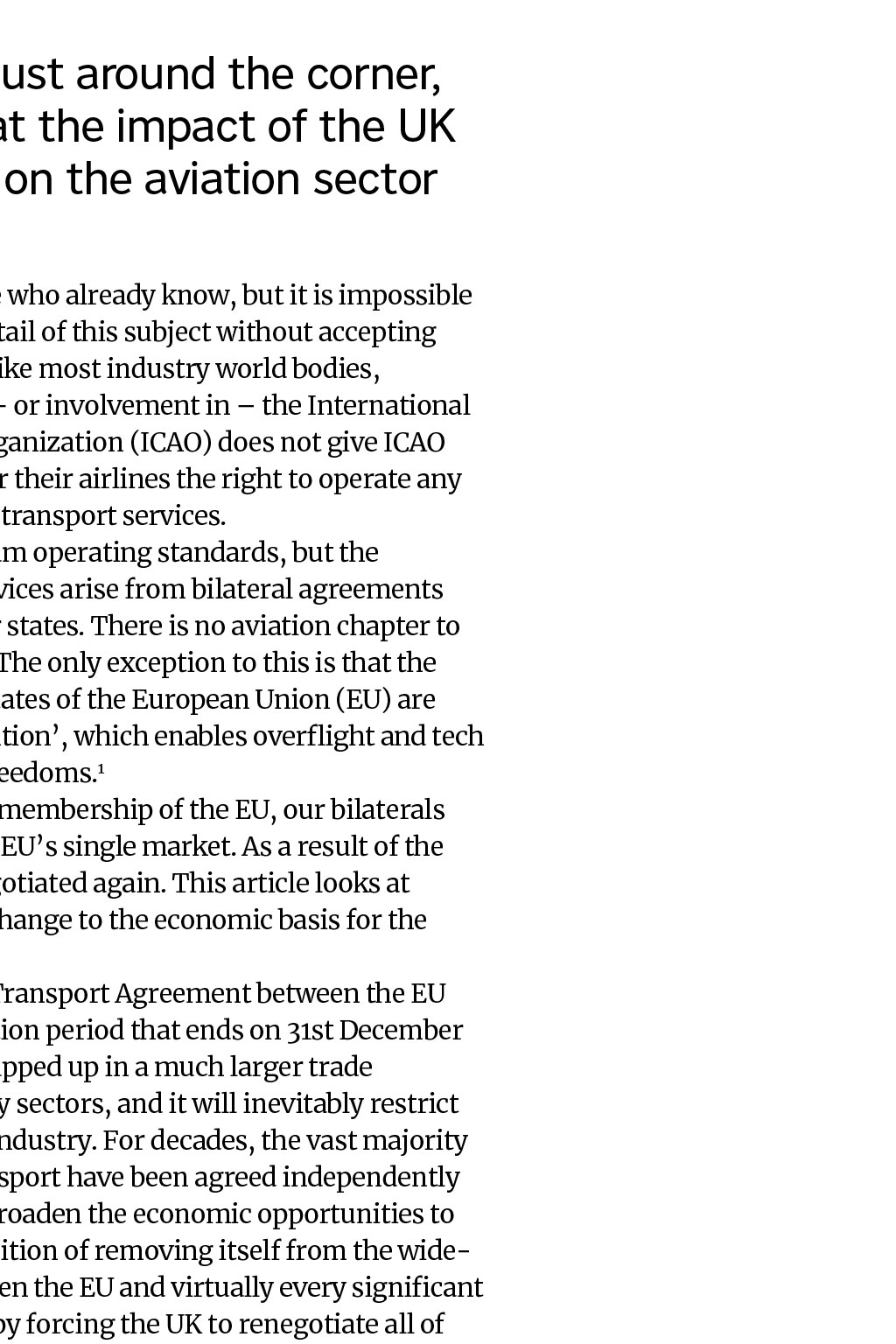
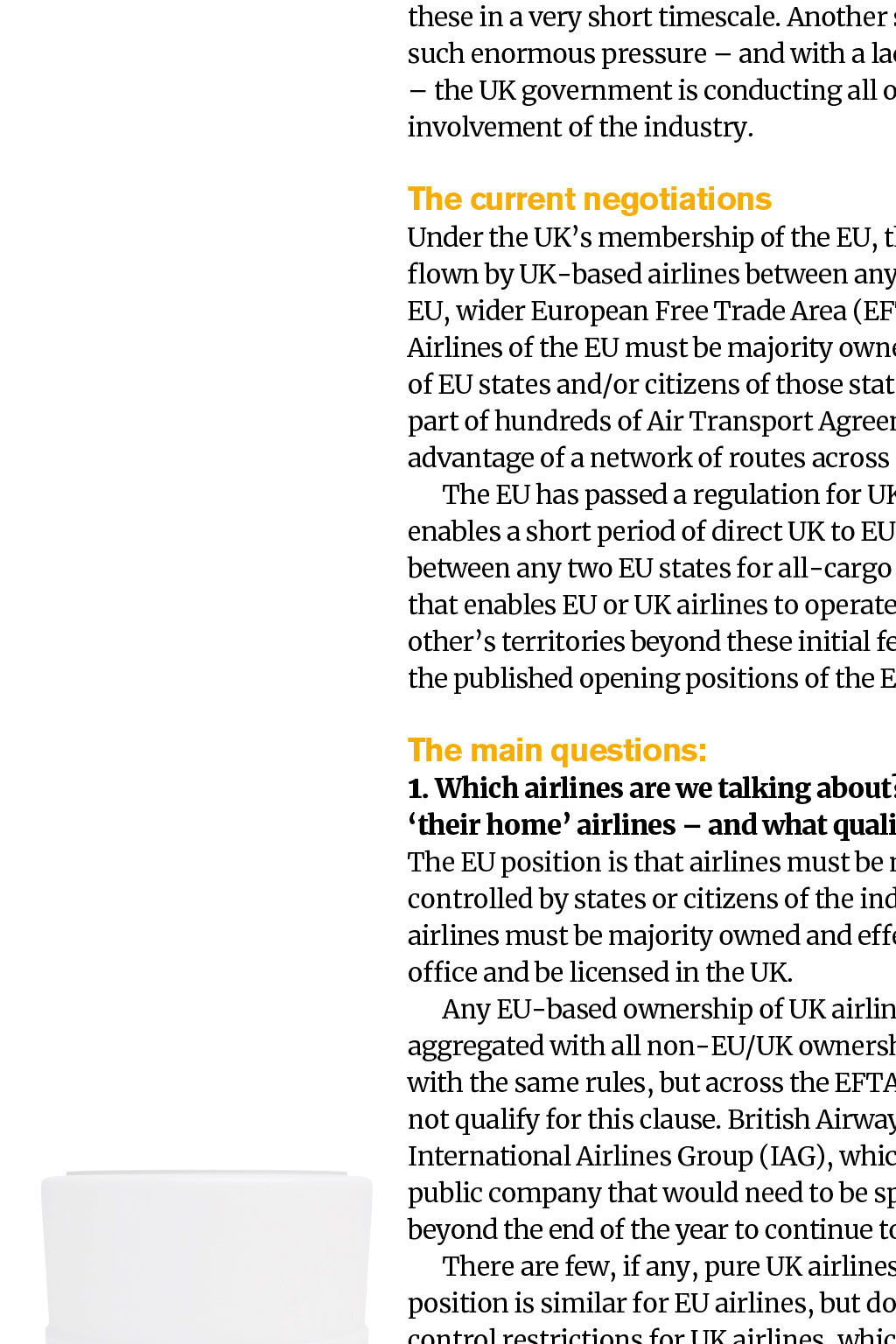
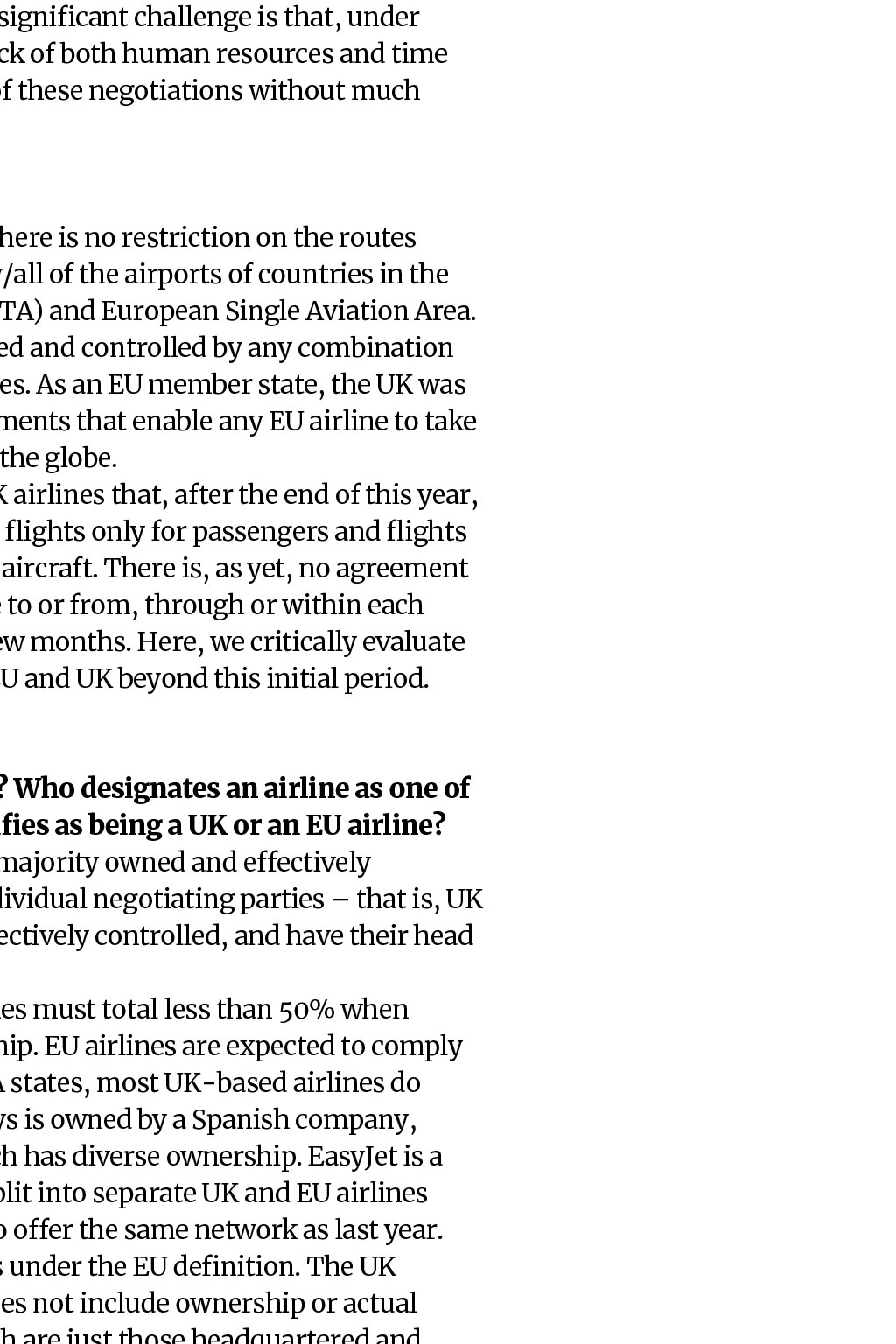
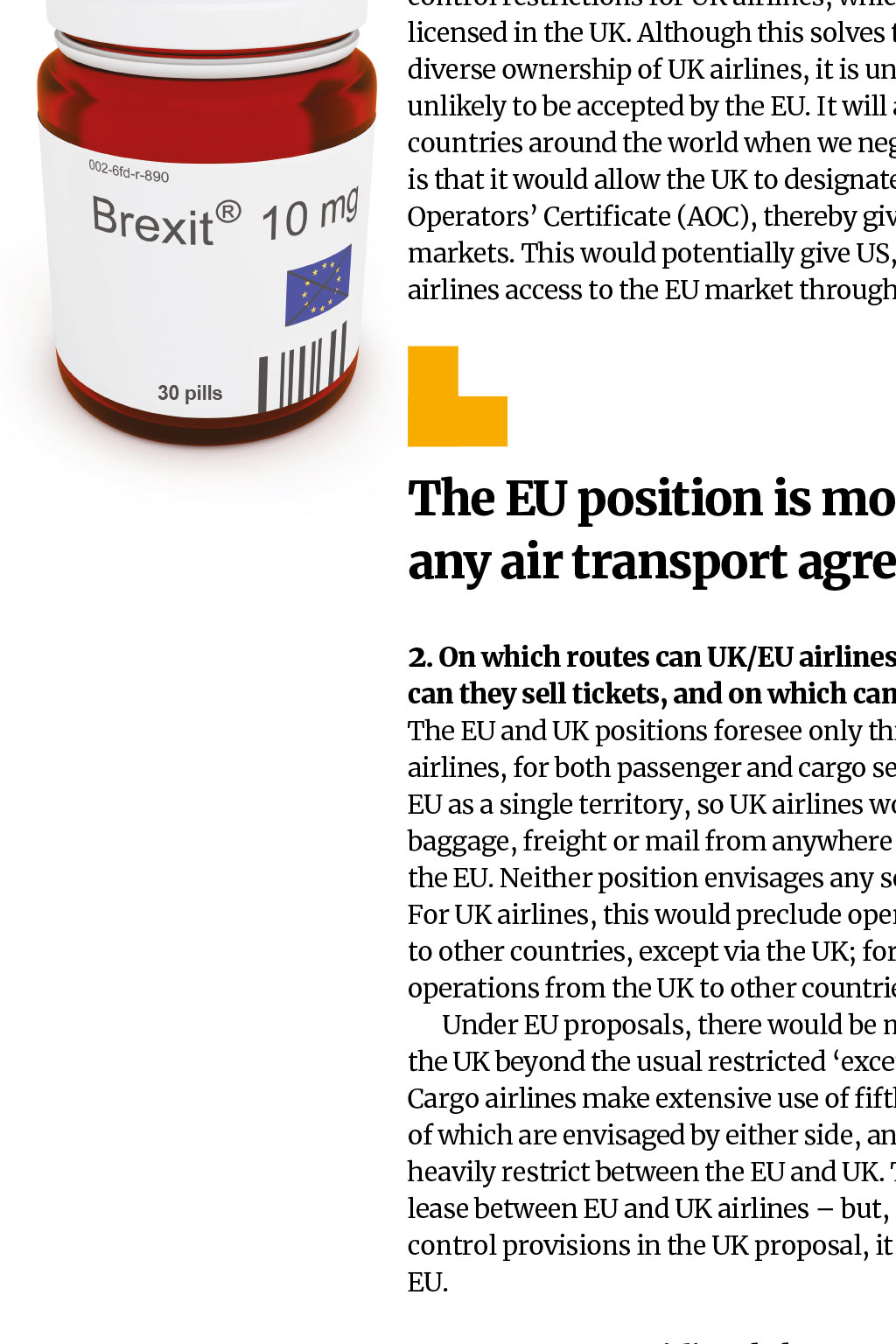
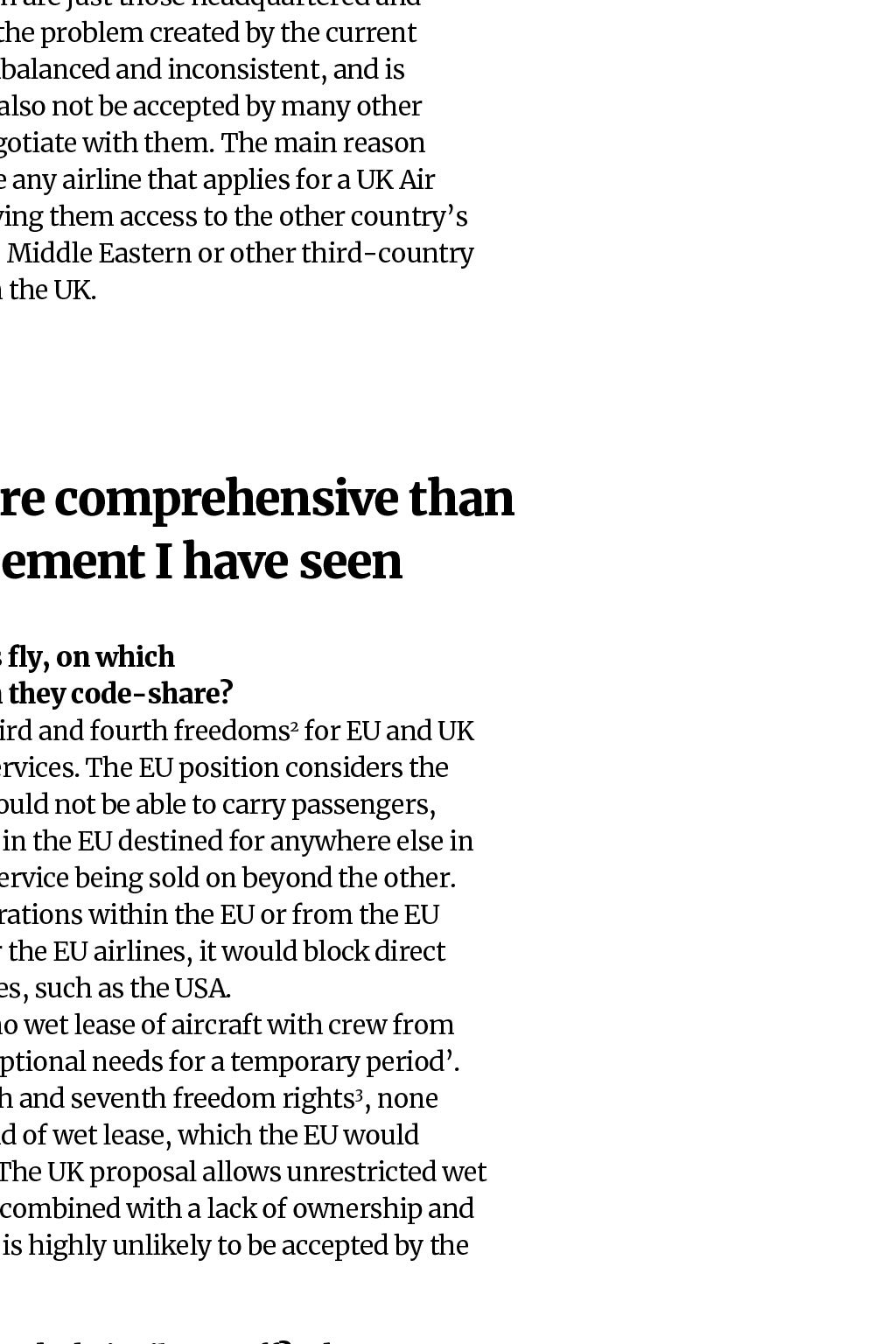
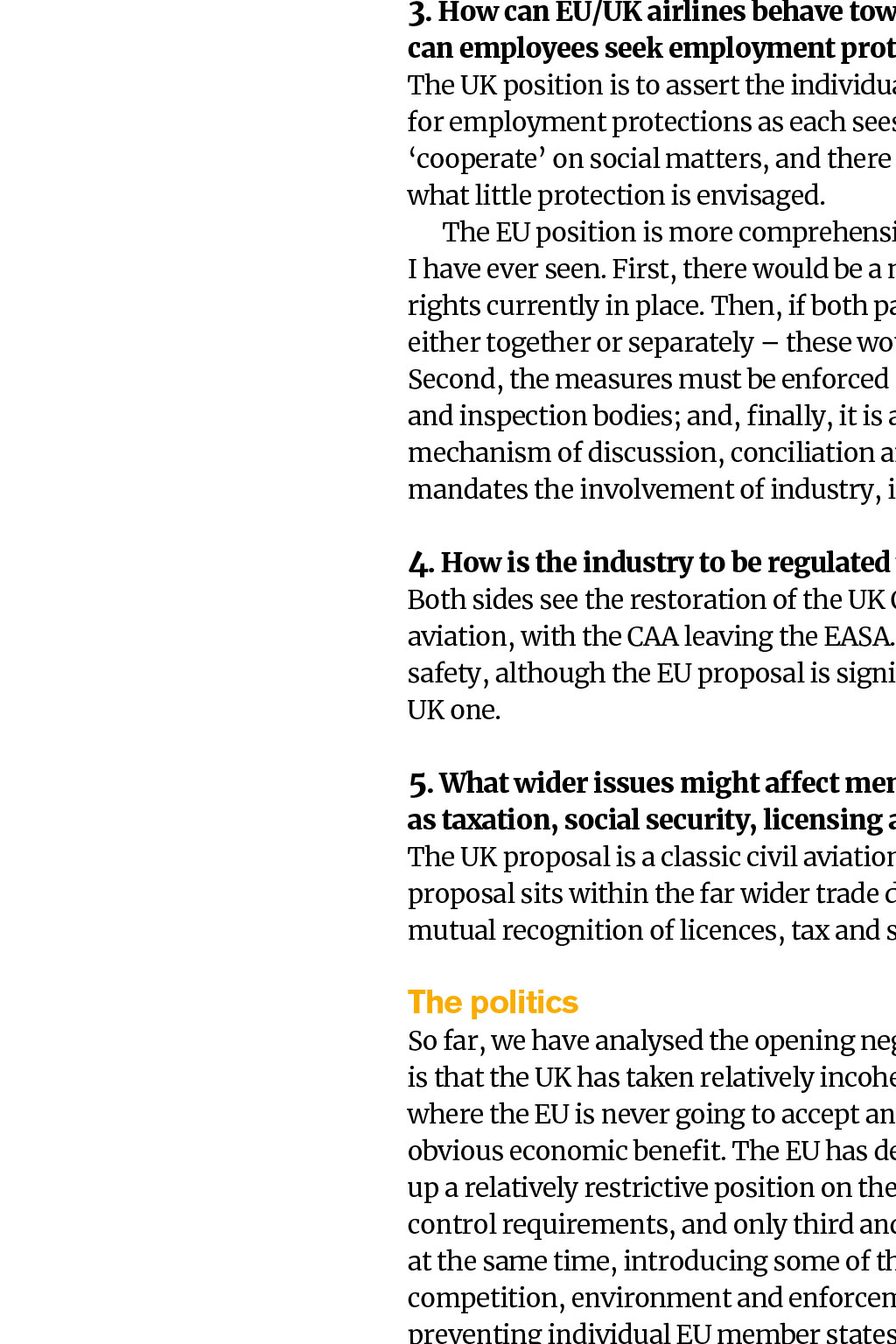
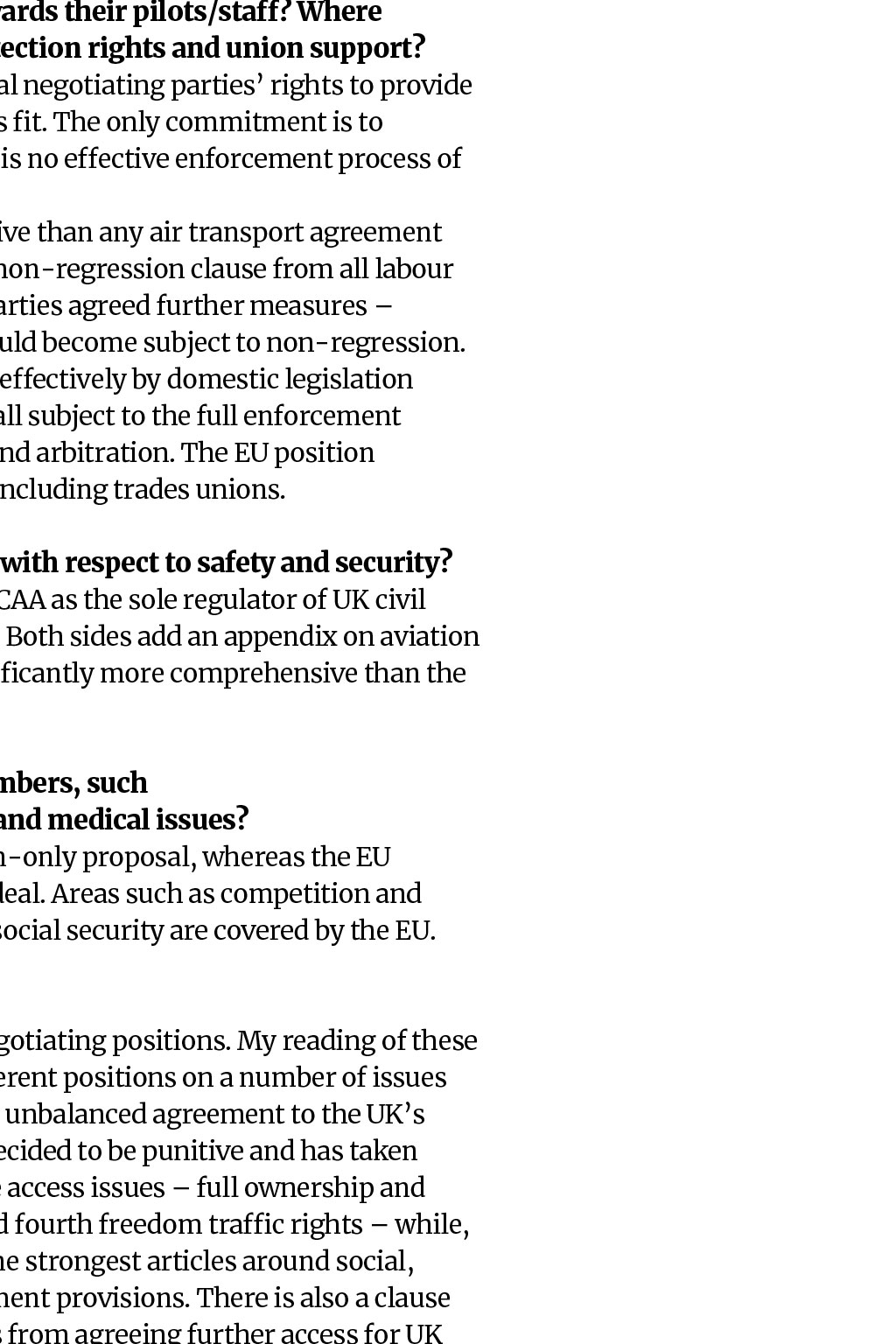
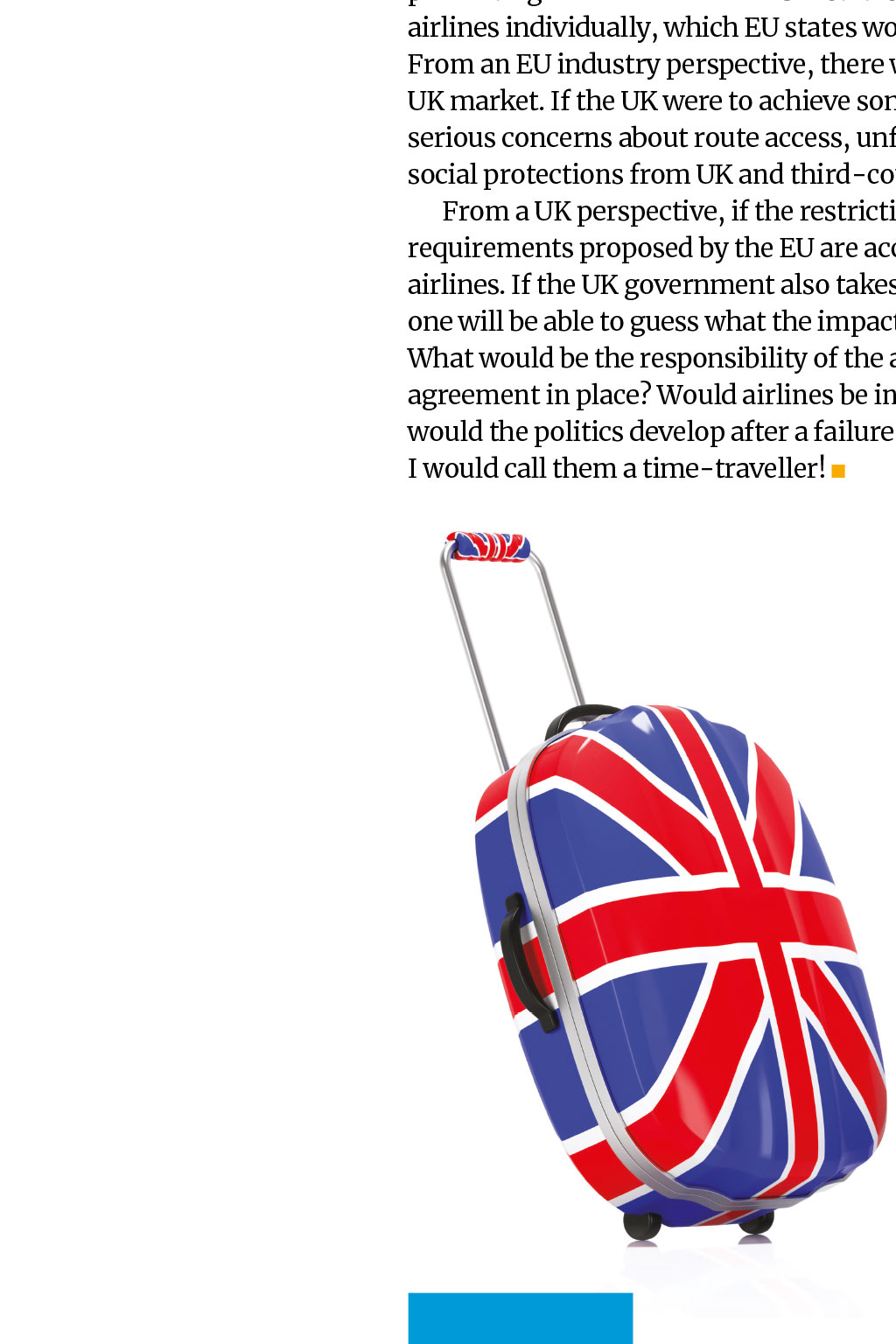
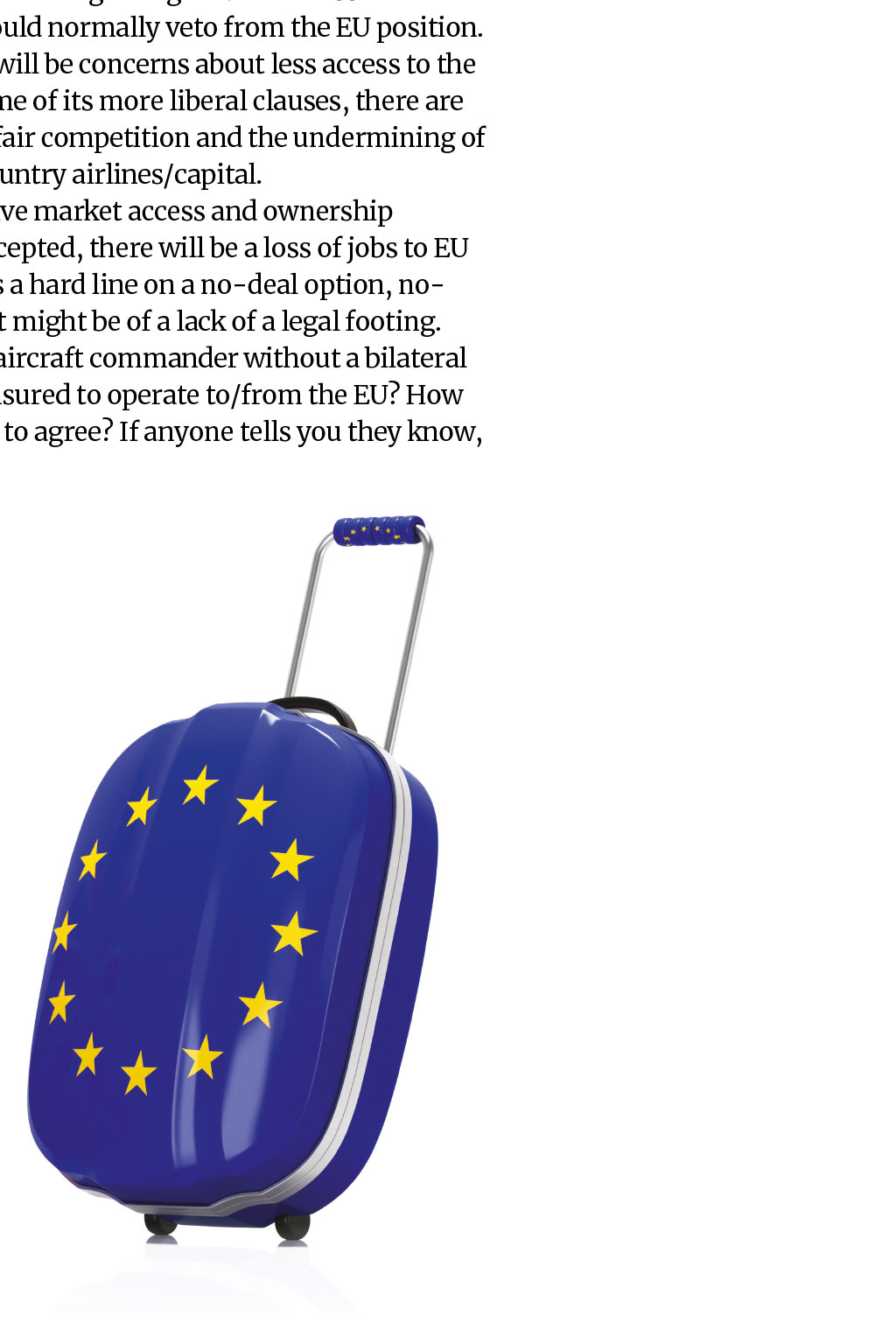
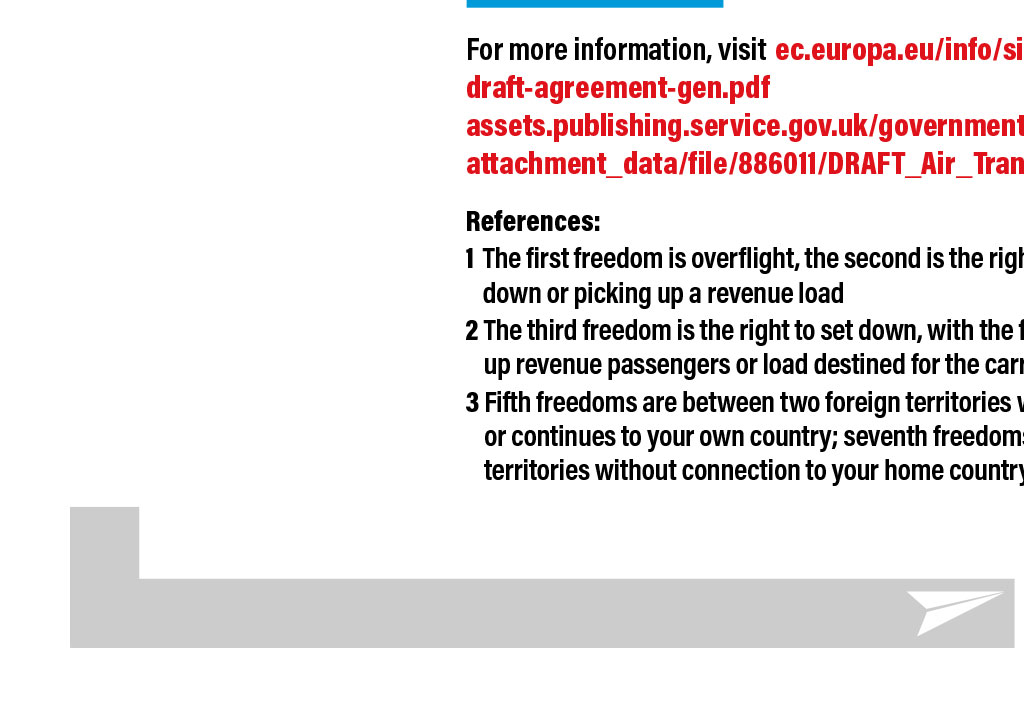
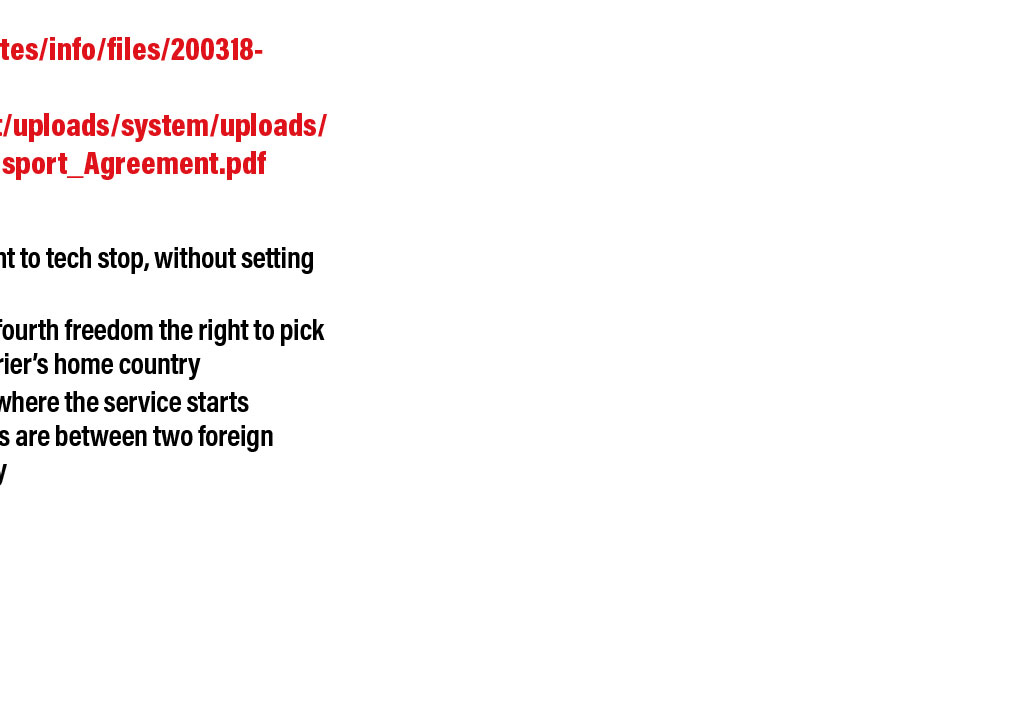














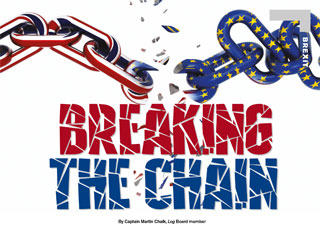
By Captain Martin Chalk, Log Board member With the end of 2020 just around the corner, it’s anyone’s guess what the impact of the UK leaving the EU will be on the aviation sector pologies to those who already know, but it is impossible to make head or tail of this subject without accepting one concept: unlike most industry world bodies, membership of – or involvement in – the International Civil Aviation Organization (ICAO) does not give ICAO member states or their airlines the right to operate any international air transport services. 30 pills ICAO is a safety body, setting minimum operating standards, but the basic economic permissions to offer services arise from bilateral agreements negotiated between those ICAO member states. There is no aviation chapter to World Trade Organization rules, either. The only exception to this is that the United Kingdom (UK) and all member states of the European Union (EU) are signatories to the ICAO ‘en route convention’, which enables overflight and tech stops – the so-called first and second freedoms.1 During the 40 years or so of the UK’s membership of the EU, our bilaterals have been renegotiated to recognise the EU’s single market. As a result of the UK leaving the EU, they need to be renegotiated again. This article looks at the challenges inherent in such a large change to the economic basis for the industry in the UK. The current renegotiation of the Air Transport Agreement between the EU and the UK, which will follow the transition period that ends on 31st December 2020, is unique for two reasons: it is wrapped up in a much larger trade negotiation that covers all other industry sectors, and it will inevitably restrict the freedoms currently available to the industry. For decades, the vast majority of negotiations on international air transport have been agreed independently of any other sector and have sought to broaden the economic opportunities to offer services. It places the UK in the position of removing itself from the wide- ranging air transport agreements between the EU and virtually every significant air transport market in the world, thereby forcing the UK to renegotiate all of these in a very short timescale. Another significant challenge is that, under such enormous pressure – and with a lack of both human resources and time – the UK government is conducting all of these negotiations without much involvement of the industry. The current negotiations Under the UK’s membership of the EU, there is no restriction on the routes flown by UK-based airlines between any/all of the airports of countries in the EU, wider European Free Trade Area (EFTA) and European Single Aviation Area. Airlines of the EU must be majority owned and controlled by any combination of EU states and/or citizens of those states. As an EU member state, the UK was part of hundreds of Air Transport Agreements that enable any EU airline to take advantage of a network of routes across the globe. The EU has passed a regulation for UK airlines that, after the end of this year, enables a short period of direct UK to EU flights only for passengers and flights between any two EU states for all-cargo aircraft. There is, as yet, no agreement that enables EU or UK airlines to operate to or from, through or within each other’s territories beyond these initial few months. Here, we critically evaluate the published opening positions of the EU and UK beyond this initial period. The main questions: 1. Which airlines are we talking about? Who designates an airline as one of ‘their home’ airlines – and what qualifies as being a UK or an EU airline? The EU position is that airlines must be majority owned and effectively controlled by states or citizens of the individual negotiating parties – that is, UK airlines must be majority owned and effectively controlled, and have their head office and be licensed in the UK. Any EU-based ownership of UK airlines must total less than 50% when aggregated with all non-EU/UK ownership. EU airlines are expected to comply with the same rules, but across the EFTA states, most UK-based airlines do not qualify for this clause. British Airways is owned by a Spanish company, International Airlines Group (IAG), which has diverse ownership. EasyJet is a public company that would need to be split into separate UK and EU airlines beyond the end of the year to continue to offer the same network as last year. There are few, if any, pure UK airlines under the EU definition. The UK position is similar for EU airlines, but does not include ownership or actual control restrictions for UK airlines, which are just those headquartered and licensed in the UK. Although this solves the problem created by the current diverse ownership of UK airlines, it is unbalanced and inconsistent, and is unlikely to be accepted by the EU. It will also not be accepted by many other countries around the world when we negotiate with them. The main reason is that it would allow the UK to designate any airline that applies for a UK Air Operators’ Certificate (AOC), thereby giving them access to the other country’s markets. This would potentially give US, Middle Eastern or other third-country airlines access to the EU market through the UK. The EU position is more comprehensive than any air transport agreement I have seen 2. On which routes can UK/EU airlines fly, on which can they sell tickets, and on which can they code-share? The EU and UK positions foresee only third and fourth freedoms2 for EU and UK airlines, for both passenger and cargo services. The EU position considers the EU as a single territory, so UK airlines would not be able to carry passengers, baggage, freight or mail from anywhere in the EU destined for anywhere else in the EU. Neither position envisages any service being sold on beyond the other. For UK airlines, this would preclude operations within the EU or from the EU to other countries, except via the UK; for the EU airlines, it would block direct operations from the UK to other countries, such as the USA. Under EU proposals, there would be no wet lease of aircraft with crew from the UK beyond the usual restricted ‘exceptional needs for a temporary period’. Cargo airlines make extensive use of fifth and seventh freedom rights3, none of which are envisaged by either side, and of wet lease, which the EU would heavily restrict between the EU and UK. The UK proposal allows unrestricted wet lease between EU and UK airlines – but, combined with a lack of ownership and control provisions in the UK proposal, it is highly unlikely to be accepted by the EU. 3. How can EU/UK airlines behave towards their pilots/staff? Where can employees seek employment protection rights and union support? The UK position is to assert the individual negotiating parties’ rights to provide for employment protections as each sees fit. The only commitment is to ‘cooperate’ on social matters, and there is no effective enforcement process of what little protection is envisaged. The EU position is more comprehensive than any air transport agreement I have ever seen. First, there would be a non-regression clause from all labour rights currently in place. Then, if both parties agreed further measures – either together or separately – these would become subject to non-regression. Second, the measures must be enforced effectively by domestic legislation and inspection bodies; and, finally, it is all subject to the full enforcement mechanism of discussion, conciliation and arbitration. The EU position mandates the involvement of industry, including trades unions. 4. How is the industry to be regulated with respect to safety and security? Both sides see the restoration of the UK CAA as the sole regulator of UK civil aviation, with the CAA leaving the EASA. Both sides add an appendix on aviation safety, although the EU proposal is significantly more comprehensive than the UK one. 5. What wider issues might affect members, such as taxation, social security, licensing and medical issues? The UK proposal is a classic civil aviation-only proposal, whereas the EU proposal sits within the far wider trade deal. Areas such as competition and mutual recognition of licences, tax and social security are covered by the EU. The politics So far, we have analysed the opening negotiating positions. My reading of these is that the UK has taken relatively incoherent positions on a number of issues where the EU is never going to accept an unbalanced agreement to the UK’s obvious economic benefit. The EU has decided to be punitive and has taken up a relatively restrictive position on the access issues – full ownership and control requirements, and only third and fourth freedom traffic rights – while, at the same time, introducing some of the strongest articles around social, competition, environment and enforcement provisions. There is also a clause preventing individual EU member states from agreeing further access for UK airlines individually, which EU states would normally veto from the EU position. From an EU industry perspective, there will be concerns about less access to the UK market. If the UK were to achieve some of its more liberal clauses, there are serious concerns about route access, unfair competition and the undermining of social protections from UK and third-country airlines/capital. From a UK perspective, if the restrictive market access and ownership requirements proposed by the EU are accepted, there will be a loss of jobs to EU airlines. If the UK government also takes a hard line on a no-deal option, no- one will be able to guess what the impact might be of a lack of a legal footing. What would be the responsibility of the aircraft commander without a bilateral agreement in place? Would airlines be insured to operate to/from the EU? How would the politics develop after a failure to agree? If anyone tells you they know, I would call them a time-traveller! For more information, visit ec.europa.eu/info/sites/info/files/200318- draft-agreement-gen.pdf assets.publishing.service.gov.uk/government/uploads/system/uploads/ attachment_data/file/886011/DRAFT_Air_Transport_Agreement.pdf References: 1 The first freedom is overflight, the second is the right to tech stop, without setting down or picking up a revenue load 2 The third freedom is the right to set down, with the fourth freedom the right to pick up revenue passengers or load destined for the carrier’s home country 3 Fifth freedoms are between two foreign territories where the service starts or continues to your own country; seventh freedoms are between two foreign territories without connection to your home country BREXIT